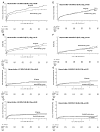Late coronary intervention for totally occluded left anterior descending coronary arteries in stable patients after myocardial infarction: Results from the Occluded Artery Trial (OAT)
- PMID: 19332202
- PMCID: PMC2696388
- DOI: 10.1016/j.ahj.2008.12.008
Late coronary intervention for totally occluded left anterior descending coronary arteries in stable patients after myocardial infarction: Results from the Occluded Artery Trial (OAT)
Abstract
Background: We analyzed a prespecified hypothesis of the Occluded Artery Trial (OAT) that late percutaneous coronary intervention (PCI) of the infarct-related artery (IRA) would be most beneficial for patients with anterior myocardial infarction (MI).
Methods: Two thousand two hundred one stable, high-risk patients with total occlusion of the IRA (793 left anterior descending [LAD]) on days 3 to 28 (minimum of 24 hours) after MI were randomized to PCI and stenting with optimal medical therapy (1,101 patients) or to optimal medical therapy alone (1,100 patients). The primary end point was a composite of death, recurrent MI, or hospitalization for class IV heart failure.
Results: The 5-year cumulative primary end point rate was more frequent in the LAD group (19.5%) than in the non-LAD group (16.4%) (HR 1.34, 99% CI 1.00-1.81, P = .01). Within the LAD group, the HR for the primary end point in the PCI group (22.7%) compared with the medical therapy group (16.4%) was 1.35 (99% CI 0.86-2.13, P = .09), whereas in the non-LAD group the HR for the primary end point in PCI (16.9%) compared with medical therapy (15.8%) was 1.03 (99% CI 0.70-1.52, P = .83) (interaction P = .24). The results were similar when the effect of PCI was assessed in patients with proximal LAD occlusion.
Conclusions: In stable patients, persistent total occlusion of the LAD post MI is associated with a worse prognosis compared with occlusion of the other IRAs. A strategy of PCI of occluded LAD IRA >24 hours post MI in stable patients is not beneficial and may increase risk of adverse events in comparison to optimal medical treatment alone.
Conflict of interest statement
No conflict of interest.
Figures


References
-
- Boden WE, Eagle K, Granger CB. Reperfusion strategies in acute ST-segment elevation myocardial infarction: a comprehensive review of contemporary management options. J Am Coll Cardiol. 2007;50:917–929. - PubMed
-
- Eagle KA, Goodman SG, Avezum A, et al. Practice variation and missed opportunities for reperfusion in ST-segment-elevation myocardial infarction: findings from the Global Registry of Acute Coronary Events (GRACE) Lancet. 2002;359:373–7. - PubMed
-
- The Occluded Artery Trial (OAT) Research Group. Design and methodology of the Occluded Artery Trial (OAT) Am Heart J. 2005;150:627–42. - PubMed
-
- Gheeraert PJ, Henriques JP, De Buyzere ML, et al. Out-of-hospital ventricular fibrillation in patients with acute myocardial infarction: coronary angiographic determinants. J Am Coll Cardiol. 2000;35:144–50. - PubMed
Publication types
MeSH terms
Grants and funding
LinkOut - more resources
Full Text Sources
Medical
Miscellaneous

